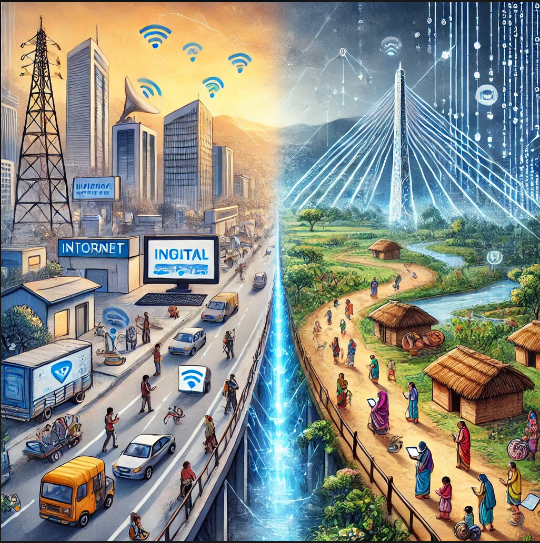Introduction
The digital revolution has transformed economies, societies, and governance worldwide, creating new opportunities for growth and development. However, this transformation has also led to a disparity known as the “digital divide”—the gap between those who have access to digital technologies and those who do not. In India, a country with vast geographical, economic, and social diversity, the digital divide remains a significant challenge. While urban areas benefit from high-speed internet and digital services, rural and underprivileged communities often struggle with limited connectivity and digital literacy.
This essay explores the digital divide in India, its causes, impact, and initiatives aimed at bridging the gap. It also examines potential solutions to ensure that digital access is equitable and inclusive, empowering all sections of society to participate in the digital era.
Understanding the Digital Divide
The digital divide refers to the disparity between individuals, households, businesses, and geographic areas in terms of their access to and use of information and communication technology (ICT). It is commonly categorized into three major aspects:
- Access Divide – The difference in availability of digital infrastructure such as internet connectivity, mobile networks, and devices like computers and smartphones.
- Usage Divide – The gap in digital literacy, preventing people from effectively utilizing technology.
- Quality Divide – The difference in the quality and speed of internet services, affecting user experience and productivity.
In India, the digital divide exists not only between urban and rural areas but also among different socio-economic groups, genders, and regions.
Causes of the Digital Divide in India
1. Socio-Economic Disparities
India has a significant economic divide, where a large section of the population lives in poverty. For many families, purchasing a smartphone, laptop, or internet connection remains a luxury rather than a necessity. Limited financial resources restrict access to digital tools and services.
2. Inadequate Digital Infrastructure
Despite advancements in internet penetration, many rural areas still lack reliable broadband connectivity. The cost of setting up digital infrastructure in remote and underdeveloped areas is high, leading to unequal access across regions.
3. Digital Illiteracy
A significant portion of the Indian population lacks the knowledge and skills to use digital devices effectively. This issue is particularly prevalent among older generations, rural communities, and marginalized groups. Without digital literacy, having internet access alone is insufficient.
4. Gender Gap in Digital Access
Women in India, especially in rural areas, face greater restrictions in accessing technology due to cultural norms, economic dependency, and lower literacy rates. According to reports, the percentage of women using the internet in India is considerably lower than that of men.
5. Language and Content Barriers
The dominance of English in digital content poses a challenge for millions of Indians who primarily speak regional languages. While there has been progress in vernacular content, a large portion of digital resources remains inaccessible to non-English speakers.
6. High Cost of Devices and Data
Although India has some of the cheapest internet data rates in the world, the affordability of devices such as smartphones, laptops, and tablets remains a challenge for many low-income families. Additionally, maintenance costs and lack of technical support further hinder digital adoption.
Impact of the Digital Divide in India
1. Educational Disparities
The COVID-19 pandemic exposed the deep-rooted digital divide in education. While students in urban areas accessed online classes, those in rural and underprivileged communities faced difficulties due to the lack of devices, internet connectivity, and digital literacy. Many students dropped out or had their learning disrupted, widening the educational gap.
2. Limited Economic Opportunities
Digital platforms provide numerous opportunities for employment, entrepreneurship, and skill development. However, those without access to digital tools are unable to participate in the digital economy, leading to economic exclusion and unemployment.
3. Barriers to E-Governance and Digital Services
The Indian government has launched various e-governance initiatives, such as Aadhaar, Digital India, and online public services. However, individuals without digital access are unable to benefit from these services, leading to exclusion from essential government schemes and welfare programs.
4. Inequality in Healthcare Access
The rise of telemedicine and digital healthcare services has improved access to medical advice and treatment. However, those on the disadvantaged side of the digital divide struggle to benefit from these services, limiting healthcare accessibility in remote areas.
5. Social and Gender Inequality
The digital divide further marginalizes vulnerable groups, including women, elderly individuals, and differently-abled people. Without digital access, these communities are unable to leverage technology for education, employment, and financial independence.
Initiatives to Bridge the Digital Divide in India
Recognizing the digital divide as a significant challenge, the Indian government, private sector, and non-governmental organizations (NGOs) have launched several initiatives to promote digital inclusion.
1. Digital India Initiative
Launched in 2015, the Digital India program aims to transform India into a digitally empowered society. Key components include:
- Expanding broadband connectivity in rural areas.
- Promoting e-governance and digital literacy.
- Enhancing digital infrastructure and cybersecurity.
2. BharatNet Project
BharatNet is one of the largest rural broadband projects in the world, aimed at providing high-speed internet to all Gram Panchayats (village councils) across India. The initiative seeks to ensure digital access in remote and underserved areas.
3. PMGDISHA (Pradhan Mantri Gramin Digital Saksharta Abhiyan)
This program focuses on digital literacy by providing training to rural citizens, especially women and marginalized groups. The goal is to make at least one person in every household digitally literate.
4. Affordable Digital Devices and Internet Services
Efforts have been made to promote affordable smartphones, tablets, and data services, particularly through partnerships between the government and private telecom companies. Initiatives such as the Jio revolution have significantly reduced data costs in India.
5. Promotion of Regional Language Content
Several platforms and content creators are working to increase the availability of digital resources in regional languages, making online content more accessible to non-English speakers.
6. Women Digital Literacy Programs
NGOs and government schemes such as STREE-SHIKSHA focus on empowering women by providing access to digital tools, training, and employment opportunities in the digital sector.
7. Expansion of Public Wi-Fi Networks
Programs like PM-WANI (Wi-Fi Access Network Interface) aim to provide free or affordable internet access in public spaces, benefiting individuals who cannot afford personal internet connections.
The Way Forward: Solutions to Bridge the Digital Divide
While significant progress has been made, further steps are necessary to ensure complete digital inclusion.
1. Strengthening Digital Infrastructure
The government must accelerate broadband expansion in remote areas by investing in fiber-optic networks, satellite internet, and 5G technology. Partnerships with private firms can help in cost-sharing and efficient implementation.
2. Making Digital Education a Priority
Integrating digital literacy into school curriculums and vocational training programs can help bridge the skills gap. Schools in rural areas should be equipped with smart classrooms and internet facilities.
3. Reducing the Cost of Digital Devices
Subsidies, tax reductions, and local manufacturing of digital devices can make smartphones, tablets, and computers more affordable. Public-private partnerships can play a role in distributing low-cost devices to students and low-income families.
4. Enhancing Cybersecurity and Digital Awareness
To promote trust in digital platforms, awareness campaigns on cybersecurity, digital fraud prevention, and responsible internet usage should be conducted at the grassroots level.
5. Encouraging Private Sector Participation
Corporate social responsibility (CSR) initiatives from tech companies can support digital literacy programs, infrastructure development, and internet access in underserved areas.
6. Fostering Inclusive Policies
Governments should create policies that ensure digital access for all, including differently-abled individuals and senior citizens, by designing user-friendly technology and accessible digital platforms.
Conclusion
The digital divide in India remains a critical challenge, impacting education, employment, governance, and healthcare. While initiatives such as Digital India and BharatNet have made progress, a more inclusive and holistic approach is needed to ensure that no one is left behind in the digital revolution. By strengthening digital infrastructure, improving digital literacy, and making technology affordable, India can bridge the digital divide and create an equitable digital future.
Ensuring that every citizen has the opportunity to benefit from digital advancements will not only empower individuals but also drive India’s economic and social progress in the 21st century.




